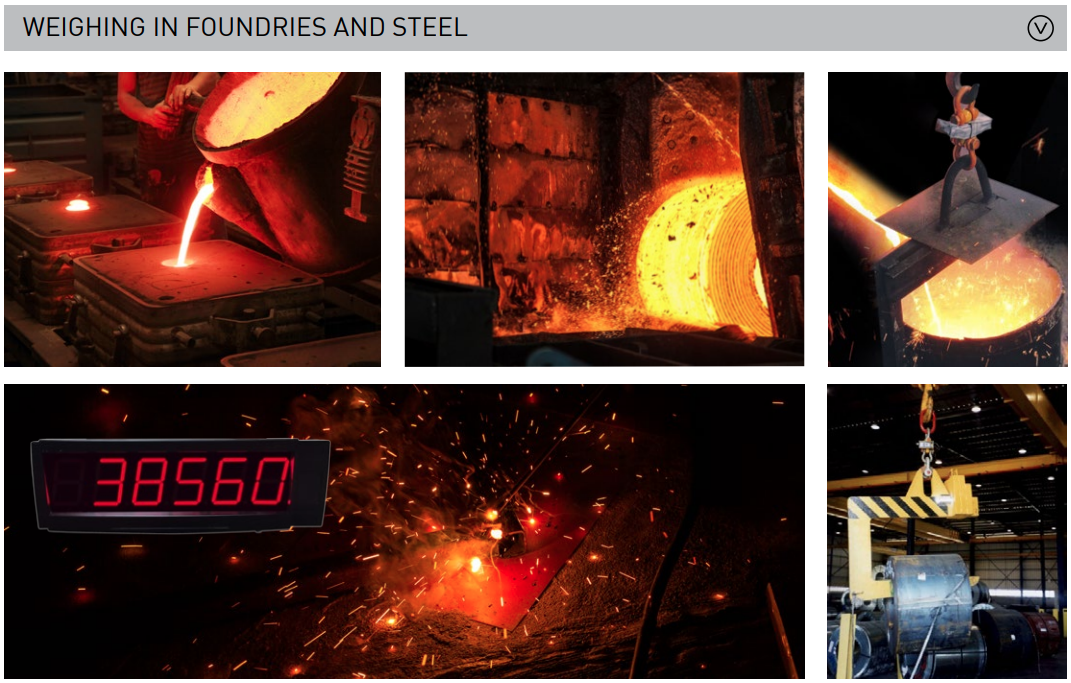High Temperature Load Cell
Designed for use in environments where a normal load cell would not survive.
What is a high-temperature load cell?
High-temperature load cells are weighing devices designed specifically to be used in extreme-heat environments such as foundries, forges, rubber processing facilities, and more. They are designed in such a way as to protect the weighing system from the extreme temperatures associated with these environments. High-temperature load cells make use of a heat shield to protect the load cell’s sensitive electronics and other mechanical parts.
Some hot work environments, such as a foundry, can exceed temperatures of 2,600 degrees Fahrenheit (1425 °C). A heat shield is necessary to protect the load cell in this harsh setting, while an internal thermometer ensures that the load cell’s electronics don’t go above 175°F (80ºC). An added bonus is that the heat shield helps prevent moisture damage by blocking vapors and fumes that might harm the weighing system.
High-temperature load cells almost always feature wireless remote technology that allows for a remote readout. This can either be a handheld indicator or a large LED display that will be easy to read from a safe distance for the entire team. Such environments are often smoky and hazy, making an LED display necessary.
How is a high-temperature load cell used?
High-temperature load cells are mainly used in foundries where workers pour molten metal into molds to produce castings. They’re used in several ways during this process.
Determining metallurgical additives
When the metals are being melted, workers add small amounts of metallurgical additives to the molten metal in the ladle. By using a load cell, workers can weigh the ladle both before and after the addition of the additives, thus determining the exact quantities of each additive for each batch.
Determining weight in the ladle
Another way in which these load cells are used in this process is to determine the total weight of molten metal in the ladle. Here, the operator can weigh the ladle both before it’s filled and then again after the metal is poured in.
Overload prevention
In extreme environments like those where a high-temperature load cell is needed, where molten metal at temperatures exceeding 1800°F, an overload situation would be extremely dangerous. Load cells help operators know the precise weight of the load they’re lifting, thus helping detect and correct any overload that might occur.

High-temperature load cell design
Here are some of the things that turn a regular load cell into a high-temperature load cell.
Heat resistance and insulation
Without a doubt, the most important design feature of a high-temperature load cell is the ability to withstand high heat. To do this, these load cells make use of three things:
- A thermal fabric jacket to cover the load cell
- A steel plate heat shield to protect it from radiant heat
- An internal thermometer to prevent overheating
Wireless capabilities
In almost all cases, you’ll need a wireless load cell to work in high-heat areas. This is where wireless radio frequency technology is used to transmit the load cell’s data to a handheld or remote display—a wired system would never be able to withstand the high-temperatures involved. A wireless load cell increases safety by allowing operators to maintain a safe working distance from the heat source. A wireless load cell can also help with visibility issues in these harsh, smoky environments.
Averaging or dampening display
Because the ladle might be swaying during weighing, getting stable readings can sometimes be difficult. For this, a good high-temperature load cell should offer the option of an average or dampening display, which will display the average weight over a short period of time, thus accounting for the effects of the swinging load.
Eilon Engineering’s wireless load cell
With more than 45 years of experience in manufacturing load cells and countless customers working in foundries and other hot environments, Eilon Engineering is proud to offer a comprehensive solution for weighing in hot environments.
Our Ron 2501 wireless load cell is the perfect tool for the job and can be purchased with the following add-ons:
- Heat shield (including a steel plate and fabric jacket)
- Internal thermometer
- Average (dampening)
- Additional wireless LED display
With the inclusion of these four options to our Ron 2501 model, you’ll get a load cell that’s ready for the most extreme environments.

Other considerations
Besides the necessary additions listed above, there are other factors to consider. First, make sure you need a hanging load cell rather than a compression-type load cell—these are quite different types of equipment and are used in different types of applications.
Next, you’ll need to know what the maximum lifting capacity will be for your application. Eilon Engineering offers a full range of load cell capacities: from large capacities like an 85-ton load cell, or even a jumbo 125-ton load cell, to small capacities starting at a half ton and upwards.
Need assistance?
If you’re not sure which options, lifting capacity, or load cell model is right for you, let us help. Speak to one of our experienced service reps by phone or email today. We’ll be happy to help you find the high temperature system that’s right for your unique weighing application.
Call us at:
US/Canada/Int'l: 1-888-778-8064
UK: 0800 8620354
Email:
sales@eilon-engineering.com












.png) Barcelona Jan 30-Feb 2
Barcelona Jan 30-Feb 2